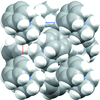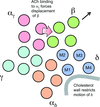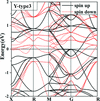issue contents
July 2017 issue

editorial
NEUTRON | SYNCHROTRON
Our notion of crystallography and how we communicate it needs to adapt to the major emerging frontiers of science in order to ensure that our community continues to thrive.
scientific commentaries
PHYSICS | FELS
Structural biology at hard X-ray free-electron lasers is evolving rapidly beyond the experimental styles long established at storage ring sources. The comprehensive review by John Spence [IUCrJ (2017), 4, 322–339] provides magisterial oversight of recent developments.
BIOLOGY | MEDICINE
A short commentary is given on the article in this issue by Nigel Unwin [IUCrJ (2017), 4, 393–399] on `Segregation of lipids near acetylcholine-receptor channels imaged by cryo-EM'.
feature articles
BIOLOGY | MEDICINE
Structure-guided drug discovery is a story of applications of protein crystallography and knowledge exchange between academia and industry. It has led to new drug approvals by the Food and Drug Administration in the USA and hope for treatment of rare genetic diseases and infectious diseases in the developing world.
PHYSICS | FELS
The use of X-ray lasers to obtain structures and molecular movies in biology is reviewed. Methods include single-particle imaging, serial crystallography and fast solution scattering at room temperature.
BIOLOGY | MEDICINE
Although the general rules governing protein crystal growth are known and a diversified panel of crystallization methods is available, producing focused protein crystals remains challenging. In the future, the supramolecular vision of crystallogenesis will break disciplinary boundaries and unify the field in a wider perspective beyond crystallization.
topical reviews
CHEMISTRY | CRYSTENG
This topical review provides a brief overview of recent developments in NMR crystallography and related NMR approaches to studying the properties of molecular and ionic solids.
CHEMISTRY | CRYSTENG
Stochastic polarity formation applies to molecular-based solid matter, in cases where the building blocks undergo 180° orientational disorder at the growing surfaces. The paper reviews progress on molecular crystals, inorganic–organic composites and natural tissues.
CHEMISTRY | CRYSTENG
The bottom-up preparation of mixed crystals, co-crystals and photoreactive materials starting from molecular building blocks across the borders of organic, organometallic and metal–organic chemistry is described.
CHEMISTRY | CRYSTENG
The `ionothermal' synthesis of metal–organic frameworks (MOFs) in ionic liquids (ILs) has led to a large number of new MOFs, often by incorporation of the IL cation as a templating counter-ion for an anionic MOF framework.
research papers
CRYO | EM
A single-particle helical reconstruction from cryo-EM images reveals a segregated distribution of lipids around acetylcholine-receptor channels in the outer leaflet of the bilayer. The existence of a cholesterol-rich microdomain next to the receptor suggests how this lipid ensures a productive conformational change when acetylcholine binds, triggering the channel to open.
PHYSICS | FELS
High-viscosity extrusion injection is an efficient means for high-throughput crystal delivery for serial measurements at synchrotrons and XFELs. Hydrogels for crystal embedding are described that are compatible with a wide range of crystallization precipitants, result in low X-ray background and afford very stable streams suitable for time-resolved measurements.
CHEMISTRY | CRYSTENG
Download citation


Download citation


The presence of halogen bonds in some hypervalent iodine and bromine derivatives is demonstrated. Hypervalent atoms in polyatomic cations and anions do have σ-holes on the extensions of their covalent bonds and the cation holes are influential on the crystal lattice structures of halonium salts.
CHEMISTRY | CRYSTENG
Download citation


Download citation


A cross-validation method is supplied to judge between various strategies in multipole refinement procedures. It easily detects when the refinement of additional parameters leads to an improvement in the model or when it simply overfits the given data.
NEUTRON | SYNCHROTRON
The shallow incidence angles used in GISAXS lead to a very large footprint of the X-ray beam on the sample. Here it is shown that, despite these large footprints, GISAXS measurements of targets with sizes down to 4 µm × 4 µm are possible.
PHYSICS | FELS
In this proof-of-principle study, the feasibility of structure determination of several proteins using serial millisecond crystallography (SMX) has been evaluated. The first high-viscosity injector-based SMX experiments carried out at a US synchrotron source, the Advanced Photon Source (APS), are reported.
PDB references: adenosine receptor A2AAR, 5uvi; lysozyme, 5uvj; phycocyanin, 5uvk; proteinase K, 5uvl
CHEMISTRY | CRYSTENG
A new method is presented for healing X-ray scattering images, allowing gaps in images to be filled and extending the image beyond the borders of the original detector exposure. This method exploits symmetry analysis to reconstruct the sample structure and thereby fill-in unmeasured regions of reciprocal space based on this automatically determined symmetry model.
CHEMISTRY | CRYSTENG
Download citation


Download citation


The salt–cocrystal continuum is a well known phenomenon in crystal engineering and has been studied here in several multicomponent solids with solid-state NMR (700 MHz) using 15N-1H heteronuclear dipolar coupling. The measurement is made at ultrafast (60–70 kHz) magic angle spinning (MAS) frequency. The experiment is sensitive enough to determine the proton position even in a continuum situation and can be performed on minimal amounts of microcrystalline or even amorphous solids with natural-abundance 15N samples. Such a measurement gives reliable values of N—H distances and is therefore a direct indication of the position of the proton in the salt–cocrystal continuum. The crystal structures of the relevant solids have also been determined at a high level of accuracy and the results of the X-ray and NMR experiments are compared.
CHEMISTRY | CRYSTENG
Download citation


Download citation


The average structure of β-Cu2−xSe is reported based on analysis of multi-temperature single-crystal X-ray diffraction data, and structural changes, including a large negative thermal expansion, across the β to α phase transition are discussed. The structural model also describes well high-resolution synchrotron powder X-ray diffraction data.
MATERIALS | COMPUTATION
A deep-machine-learning technique based on a convolutional neural network (CNN) is introduced. It has been employed for the classification of crystal system, extinction group and space group for given powder X-ray diffraction patterns of inorganic materials.
BIOLOGY | MEDICINE
Multiple structures obtained from one crystal of copper nitrite reductase at elevated cryogenic temperature, together with molecular-dynamics simulations, reveal catalyically important protein and solvent dynamics at the active site.
MATERIALS | COMPUTATION
The effect of swap disorder on the physical properties of the quaternary Heusler alloy PdMnTiAl is described from first principles.



 journal menu
journal menu




 access
access

































